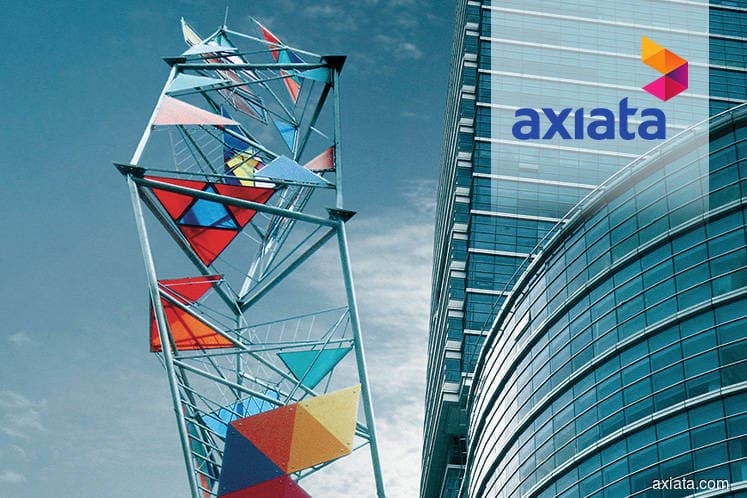
This article first appeared in The Edge Malaysia Weekly on February 18, 2019 - February 24, 2019
FOLLOWING Axiata Group Bhd’s cashing out RM1.65 billion through the sale of a 28.7% stake in Singapore’s M1 Ltd, shareholders can now pin more hope on the group keeping its promise to normalise the dividend payout for its financial year ended Dec 31, 2018 (FY2018), to the level of FY2015.
Axiata completed its two-year dividend payout sabbatical — for FY2016 and FY2017 — prioritising capital expenditure and laying the foundations for greater growth in the future.
Last Friday, Axiata accepted the take-over offer of S$2.06 per share for its entire stake in M1 by Keppel Corp Ltd and Singapore Press Holdings Ltd.
The divestment will give the telco RM1.65 billion, with an estimated gain of RM126.5 million. Some quarters believe the additional cash will enable it to be more generous in declaring dividends.
Nonetheless, in a filing with Bursa Malaysia, Axiata says it plans to use the money for general corporate purposes and/or repayment of debt.
Sources close to the telco tell The Edge that Axiata is likely to stick to its dividend sabbatical stance.
Over the past five years, Axiata has been paying dividends twice a year. In FY2016, it paid out eight sen per share and in FY2017, 8.5 sen per share.
In FY2018, it declared an interim dividend of five sen per share, compared with eight sen per share in FY2015 and prior to that. Axiata rewarded shareholders with annual dividends of at least 20 sen per share from FY2012 to FY2015.
To keep its promise to normalise dividend in FY2018, Axiata will have to declare a dividend of 15 sen per share in its upcoming final payout, which is equivalent to RM1.36 billion, based on its current share base of 9.07 billion.
Axiata paid a total of RM1.8 billion in dividends in FY2015, which is equivalent to a dividend payout ratio (DPR) of 85%. The amount paid out shrank to RM715.5 million or a DPR of 50% in FY2016, and RM766.62 million or a DPR of 64% in FY2017.
Impairment expected to weigh on earnings
Axiata will be releasing its fourth-quarter and full-year financial results on Friday.
Market consensus does not expect a stellar set of numbers amid expectations that the telco’s earnings will be dragged by several non-cash drawbacks, including impairments arising from modernisation and technology changes in certain markets.
On top of that, the strengthening of the ringgit has worked against the telco’s earnings from abroad.
Already, Axiata is down with a net loss of RM3.37 billion for the first nine months ended Sept 30, 2018 (9MFY2018), compared with a net profit of RM884.76 million in the previous corresponding period.
CIMB Research analyst Foong Choong Chen wrote in a research note last week that Axiata’s earnings per share (EPS) in the fourth quarter ended Dec 31, 2018, were expected to be hit by significant asset impairments at PT XL Axiata Tbk in Indonesia, Celcom Axiata Bhd, Robi Axiata Ltd in Bangladesh and Idea Cellular Ltd in India, mainly for 2G network assets and billing support systems.
It is worth noting that Axiata also faced a substantial impairment of RM3.38 billion earlier in FY2018 due to its dilution of shareholding in Idea Cellular following the Indian associate’s merger with Vodafone India Ltd.
Meanwhile, there is a NPR61 billion (RM2.16 billion) tax issue going on between Axiata’s Nepal unit Ncell Pvt Ltd and the government there.
That said, Axiata’s Indonesia and Sri Lanka operations are expected to perform quite well in FY2018, according to sources close to the telco.
“The price competition in Cambodia is not as bad as before. The group’s profit margin in Nepal is also getting better,” says the source. However, the source notes that its home operation, Celcom Axiata, is still grappling with squeezed margins. Its profit margin could be worse than that of other local players, the source adds.
CIMB’s Foong, however, pointed out that these were non-cash charges and should not impact the group’s dividend payout.
“The headline EPS may look weak but on the flip side, the EPS for FY2019 and future years will be boosted by lower depreciation on a smaller asset base,” he wrote in the research note.
Nonetheless, it is not all doom and gloom for Axiata, considering that it has the most “buy” calls from equity analysts among telco stocks.
Foong recommended that his clients add Axiata shares to their portfolios.
In 2016, when Axiata told shareholders to be prepared for lower dividends, its share price fell 22.7% from RM5.90 to RM4.56 that year. But the stock rebounded 23.3% the following year to RM5.39 as the group’s overall performance and dividend improved.
Last year, however, Axiata’s share price was on a downward trend again, falling to a low of RM3.25 — the lowest since October 2010. The stock ended the year at RM3.93, down nearly 26%. Recently, it was hit by the tax problem in Nepal.
On Feb 6, Nepal’s Supreme Court ruled that Axiata, as the major shareholder of Ncell, is obliged to pay a capital gains tax, excluding late fees and fines, for acquiring the Nepalese telco in April 2016.
However, Axiata said it has not received any details on the judgment and order from the court.
Should Axiata normalise its dividend, will it be appealing again?
Save by subscribing to us for your print and/or digital copy.
P/S: The Edge is also available on Apple's AppStore and Androids' Google Play.